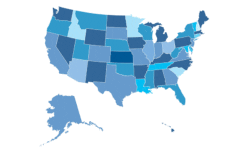Your Key to Effective Lockdowns
One of the most basic and important functional protocols for academic environments is the lockdown, yet no one solution can meet the needs of every campus or district. There are some best practices, however, that can be followed so the appropriate procedures and policies are implemented.

Incorporate Self-Directed Decision Making
One extremely important aspect of lockdowns involves the use of directed as well as self directed decision making authority. If staff members are trained to be reliant upon a command from a central authority, a tragedy could occur if a dangerous individual started an assault in a location where staff members become aware of the threat before the central authority is notified.
In the same manner, it is important that personnel assigned to reception areas and main office areas be empowered and trained to initiate all life saving functional protocols, such as lockdowns and shelter in place for a chemical incident. While this approach understandably makes some campus administrators nervous, it is the only way to ensure that a life or death decision is not delayed should the decision making authority not be present when initial notification is made.
Not All Lockdowns are Created Equal
While it is best to keep lockdown protocols relatively simple and easy to use under stress, many campus organizations have more than one lockdown option to choose from. For example, during a police chase in the area around campus, a preventive lockdown can be used to limit access while faculty continues to teach. On the other hand, an emergency lockdown can be used for situations where information indicates there is imminent danger, such as a gunman on campus.
The emergency lockdown procedures are typically more extreme but offer greater protection. Of course, if two lockdown options are used, they should be distinctly named and described in plans. It is also critical that easily understood instructions are provided. When a lockdown is ordered, administrators must clearly identify which version is required.
Implement Appropriate Emergency Alert Solutions
Modern technologies and equipment provide campus organizations with a variety of methods to notify people of the need to lockdown. Ideally, redundant systems can be utilized, and the solutions should be matched to the local situation and type of campus organization.
For example, significant differences exist between K-12 schools and institutions of higher learning. The specific issues relevant to your situation should be addressed in the lockdown protocols and notification systems selected. (For additional information on mass notification solutions, visit www.campussafetymagazine.com/MassNotification.)
If you appreciated this article and want to receive more valuable industry content like this, click here to sign up for our FREE digital newsletters!
 Leading in Turbulent Times: Effective Campus Public Safety Leadership for the 21st Century
Leading in Turbulent Times: Effective Campus Public Safety Leadership for the 21st Century
This new webcast will discuss how campus public safety leaders can effectively incorporate Clery Act, Title IX, customer service, “helicopter” parents, emergency notification, town-gown relationships, brand management, Greek Life, student recruitment, faculty, and more into their roles and develop the necessary skills to successfully lead their departments. Register today to attend this free webcast!








